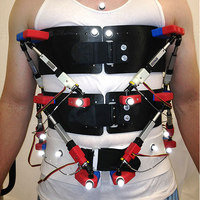RoSE Exoskeleton Helps Treat Spinal Deformities
 Apr-11-18
The RoSE robotic exoskeleton is the first dynamic brace able to measure torso stiffness to help treat spinal deformities.
Apr-11-18
The RoSE robotic exoskeleton is the first dynamic brace able to measure torso stiffness to help treat spinal deformities.Developed by a team at Columbia University, the Robotic Spine Exoskeleton (RoSE) is made up of three rings that wrap around the pelvis, mid-thoracic and upper-thoracic areas of the spine. The rings are attached to twelve limbs equipped with sensors, joints and actuators that apply pressure to the torso, allowing the device to measure the stiffness of the spine.
The team believes the RoSE could offer a new way to treat spinal deformities, particularly those that occur in children, by providing a more comfortable, flexible design.
